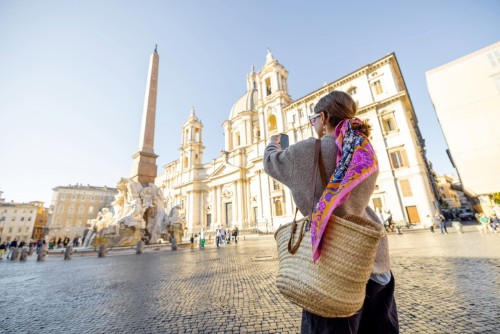What is the Best Time to Visit Germany?
Learn the best time to visit Germany by season, explore festive events, enjoy ideal weather, and get packing tips to make your trip enjoyable year-round.
When to Visit Germany?
-
Germany offers unique experiences throughout the year, with summer ideal for festivals and winter for Christmas markets, while spring and fall provide mild weather and smaller crowds.
-
Northern cities like Hamburg are best visited in spring and summer, while southern regions such as Bavaria shine during fall and winter with hiking and skiing opportunities.
-
Getting travel insurance and booking accommodations and tickets early during peak seasons like summer and major festivals helps avoid last-minute hassle and ensures better options.
Germany has something for every traveler all year round, from the countryside and medieval towns to bustling urban life. Choosing the right time depends on your interests, whether you like warm summer festivals or bustling winter markets. This guide will help you find the best time to visit Germany and make the most of your trip.
Best Time to Visit Germany Based on Travel Seasons
The land of striking contrasts, Germany, transforms with each passing season, offering a unique experience throughout the year. Whether outdoor adventures or cultural events are your calling or you are looking for recreational experiences, there’s a time for you to visit. Let’s get into it by season.
Peak Tourist Season (June to August)
Summer is the high travel season in Germany. Joyous laughter is all around with the onset of festivals in these months. Oktoberfest preparations (starting in September), Berlin’s Carnival of Cultures, Rheingau wine festival, and many music festivals occur during this time. Travelers flock to the bustling city roads and open-air concerts in the major touristy cities. It’s a great time to sightsee, enjoy outdoor cafés, boat, or cruise in the lakes. The Bavarian Alps are perfect for hiking and other outdoor activities in warm weather.
Accommodation and flight prices are the highest in summer. Popular destinations like Berlin, Munich, and Frankfurt are packed with travelers, often to the point of being shoulder-crammed. Temperatures can get pretty hot, especially in cities.
This is the best time for families, festival goers, and those who like warm weather activities like hiking, cycling, and swimming. The atmosphere is lively and adds to the whole German culture and nature.
Off Season (December to February)
In the colder months of winter, the crowds get thinner, and Germany transforms into a setting perfect for cozy getaways. The seasonal markets and festive celebrations attract tourists and locals alike. The Christmas markets of Nuremberg, Munich, and Cologne are among the few famous ones and a must-see for their varieties of lights, crafts, and seasonal goodies.
It snows in winter, covering the castles, forests, and towns in snow alike. Do not miss the opportunity of skiing and snowboarding in the Bavarian Alps if you are into skiing and snowboarding. You must also visit the town of Rothenburg ob der Tauber, offering breathtaking views of snowy landscapes. Whether for outdoor adventures or cozy moments in towns, Germany offers a peaceful yet captivating experience even in the off-season.
Shorter days are all about festive lights and warm moments. Lower travel and accommodation prices make winter a budget-friendly season.
Shoulder Seasons (March to May and September to November)
If you visit Germany in spring and autumn, you'll get to enjoy pleasant weather, fewer tourists, budget accommodation, and beautiful landscapes.
Spring restores the lively colors while reviving the charm and bustle of the towns. This time of the year calls for outdoor activities like hiking and sightseeing in the Black Forest or exploring the Rhine Valley. You can experience traditional festivals like Frühlingsfest (Spring Festival) in Munich and Stuttgart between mid-April and early May. Wine festivals in the Rhine and Moselle valleys celebrate the grape harvest, so it’s a great time for wine lovers to indulge in wine tasting galore while enjoying the crisp air.
Fall is a beautiful time to visit due to the stunning hues of landscapes and foliage. Reds and yellows don the streets, making for a perfect setting for leisurely walks. Fall is also a great time for hiking in the Black Forest. Early fall can still be busy, especially in Munich, due to Oktoberfest, which is the big highlight of the fall season. You must visit this world-famous festival for its food and, of course, beer. As November approaches, there are fewer tourists, but the atmosphere is still lively, with cozy cafes serving warm seasonal treats.
Shoulder seasons are perfect for nature lovers and history buffs who prefer moderate crowds. Germany’s true essence shines in the shoulder seasons when the landscapes are painted in lively colors. The weather can be unpredictable sometimes, with a few rainy days, but it is perfect to explore German culture and nature.
How Germany’s Monthly Weather Impacts Travel Plans
Germany’s weather changes a lot throughout the year, making it essential to pack with the changing conditions in mind. Knowing what to expect each month of the year helps you prepare for your trip. Here’s a quick month-by-month guide to the country’s weather and how to pack accordingly.
-
January & February: These are the coldest months of the year. Regions in South Germany, especially the Bavarian Alps, are covered in snow. If you are planning for outdoor activities in these months, pack warm layers, a heavy coat, gloves, and sturdy boots.
-
March & April: These months mark the transition into spring; the weather during this time can be quite unpredictable. There might be chilly mornings and contrastingly warm afternoons, with a common occurrence of rain. Pack light layers with a waterproof jacket to adjust to temperature fluctuations and sudden showers.
-
May & June: These months are perfect for outdoor activities as they offer mild to warm temperatures. Pack light layers for comfortable movement, but expect occasional rainfall. A pair of snug walking shoes along with a lightweight rain jacket is recommended to pack along.
-
July & August: These are the warmest months, offering ideal temperature conditions for summer activities. The longer days provide ample time for hiking and sightseeing. Pack light clothing with the perfect fitting shoes. Bring light rain gear for a sudden downpour.
-
September & October: Fall brings cool and crisp air with mild afternoons and chilly evenings. Warm layers are needed, especially at night. Pack a jacket for outdoor activities. If exploring urban and rural areas on foot, do not forget to pack snug, comfy shoes.
-
November & December: These months mark the approaching winter, and snow in the south is more likely. Pack heavy winter clothes to stay warm in the biting cold weather of Germany. Add waterproof jackets, insulated pants, and snow boots if you plan to ski in the Alps.
Germany’s weather can be unpredictable in spring and fall. If you are planning your trip around this time, be prepared by packing layers or bring a rain jacket or umbrella just in case. Don’t let the weather ruin your trip to Germany. Consider a travel insurance plan with trip interruption, trip delay or missed connection coverage
How Best Time to Travel to Germany Varies by Regions
Germany’s regions are different and showcase unique seasonal experiences. Here’s a breakdown of the best times to visit each region and what they offer throughout the seasons.
Northern Germany
North, with cities like Hamburg and Bremen, has a lot to offer throughout the year. The best time to visit North Germany is late spring to early autumn, which is, May to September. In these months, you’ll find the temperatures to be mild and suitable for outdoor activities.
In Hamburg, you can walk the waterfront from April to November. There are many festivals during this time, like the Cherry Blossom Festival and Elbjazz. The Hamburg Port Anniversary in May and Hamburg Pride at the end of July are also not to be missed.
Bremen and the surrounding area have an oceanic climate and are at their most beautiful in spring. Summer is for relaxing in the maritime side of the city, for example, the charming town square of Bremen is lively and beaming in sun while it's also perfect for outdoor dining. Autumn is for leisurely walks under the colored trees and warm golden days.
If cool weather and thin crowds are your thing, visit in late autumn. You can see the fall foliage in the parks and gardens during this time.
Eastern Germany
The best time to visit East Germany is May to September, during which, cities like Dresden and Leipzig come to life with weather perfect for exploring the local architecture.
But since summer is the peak travel season, it can be busier and more expensive. Still, it is the perfect time for outdoor activities like barbecues, picnics, and city exploration by bike or river cruises. Also, Leipzig hosts several music festivals during the summer months, including the Wave-Gotik-Treffen in May.
Both cities of the region have Christmas markets with festive vibes, and you can also have a taste of local traditions and seasonal treats.
Western Germany
The best time to visit West Germany, with cities like Frankfurt, Cologne, and Düsseldorf, is from spring to autumn. These seasons fall between May and September when it is warm for visiting the Cologne Cathedral or enjoying the Rhine River promenade in the golden hour.
In summer, the cobbled streets and central fountain are perfect for dining and cultural exploration. You can also stroll through Palmengarten in Frankfurt. Even in mid-summer, this botanical garden is not as crowded as other tourist attractions. Outdoor events like art exhibitions and food festivals take place during the summer in Düsseldorf.
If thick crowds are not your thing, visit Germany in late autumn. You can see the fall colors and cozy cafés during this time. Romerberg is the public space for Frankfurt’s Christmas market in December. Cologne’s Carnival in February attracts many visitors. This is a great opportunity to see the local traditions.
Southern Germany
South Germany, especially Munich and Nuremberg, is best visited from late spring to early autumn. May to September is all for preparations for Oktoberfest in Munich, which takes place from late September to the first weekend in October.
You can also explore Nuremberg’s medieval architecture and lively markets during this time. Spring offers nice weather and is a good time to visit the English Garden in Munich or to enjoy the views from Nuremberg’s castle.
Augsburg, Füssen, and Munich are especially beautiful in autumn and fall. The colors add a bold statement, whether you’re in Augsburg’s old town, Füssen’s landscapes, or Munich’s architecture. The best time for winter sports is November to February, and for hiking is April to October.
For a more quiet experience, travel in winter. With festive lights and a holiday atmosphere all around, Christmas markets are a bonus. The cold season is perfect for trying local specialties and skiing in the snow-covered Bavarian Alps.
Travel Tips for Visiting Germany
Planning your Germany vacation takes more than just picking the right season to explore the beautiful country. These practical tips will help you steer through the country’s unpredictable weather, cultural events, and local norms, ensuring a delightful and enjoyable experience.
Planning for Weather Conditions and Events
Always check the forecast before you head out, and be prepared for changes. If you’re attending seasonal events like Christmas markets in winter, pack warm winter coats and layers. In summer, lightweight clothes and comfy shoes are essential for outdoor activities like hiking. An umbrella and light rain gear can help protect against unexpected rainy days.
What to Pack
Flexibility in your wardrobe goes a long way due to seasonal variations and unexpected weather shifts. In winter, bring heavy and warm layers for outdoor activities. For spring and fall, light layers are key to adjusting to the temperature fluctuations. To ward off surprising showers of rain, don’t forget to pack a waterproof rain jacket. Summer packing should include light, breathable clothing. Packing comfortable, snug shoes for walking around and sturdy, anti-slip boots for going out in the snow is wise.
Travel Insurance
When traveling to a foreign country, it is best to get covered for unexpected medical events during your trip. If engaging in outdoor activities, ensure your travel insurance policy provides coverage for medical emergencies. If renting a car to get around in Germany, your travel insurance policy should include a rental car damage waiver. It’s always best to get a travel insurance policy to meet your needs and add value to your trip. AXA Travel Insurance offers travel insurance policies with these benefits and many more.
Booking in Advance
During peak season (summer or festivals like Oktoberfest and Christmas), book accommodations and tickets early to ensure getting the best options and avoid last-minute hassle. Guided skip-the-line tours are available in most cities, but keep in mind that advance bookings for these can be quite costly.
Off-Season Benefits
Traveling in late fall or winter has its benefits. You’ll find cheaper flights, hotels, and other accommodations. If you prefer quiet and calm over chaos and crowds, this is the time to visit Germany. It’s the perfect time to visit cultural sites with fewer people and enjoy local attractions at a more relaxed pace and on a budget.
Language
While English is spoken in many tourist areas, learning some German phrases can help you get more out of your experience. Simple greetings and polite words go a long way in connecting with locals. Whether you’re ordering something at a restaurant or asking for directions, these phrases will make daily interactions smoother.
FAQs
1. What is the best time of year to visit Germany for sightseeing?
The best time for sightseeing is spring (March to May) and fall (September to October) when the weather is nice and tourist crowds are not too bad. Shoulder season is when the Spring Festivals of Munich and Stuttgart and Oktoberfest in Munich happen.
2. When is the weather most pleasant in Germany?
The best weather is in late spring and early fall, with mild temperatures and almost no rain, perfect for outdoor activities.
3. What are the top festivals in Germany, and when are they held?
The top festivals are the Spring Festivals (April to May), Carnival of Cultures (May to June), Oktoberfest (late September to early October), Cologne Carnival (November), and many Christmas markets (late November to December).
4. How crowded are Germany's Christmas markets in December?
Christmas markets can be flocked with visitors in December, especially on weekends and holidays.
5. What are the best regional dishes to try when visiting Germany?
Try sauerbraten, bratwurst, and regional specialties like pretzels and Black Forest cake and Allerlei in Leipzig. Do not miss the Kolsch Beer when in Cologne.

Travel Assistance Wherever, Whenever
Speak with one of our licensed representatives or our 24/7 multilingual insurance advisors to find the coverage you need for your next trip. Contact Here
Related Articles
Do I need Travel Insurance
How to Buy Travel Insurance
How Much Does Travel Insurance Cost?
Germany
Travel Requirements Germany
Is It Safe: Germany
Best Places In Germany




